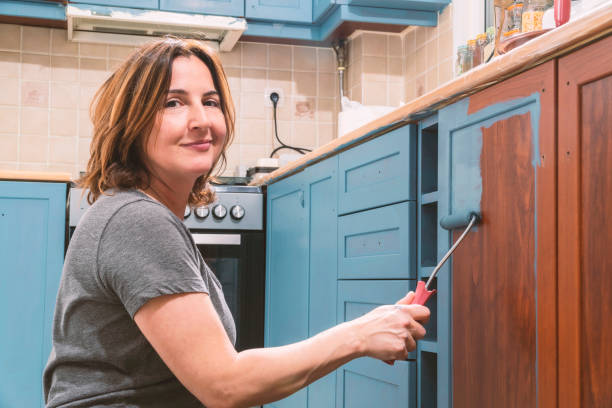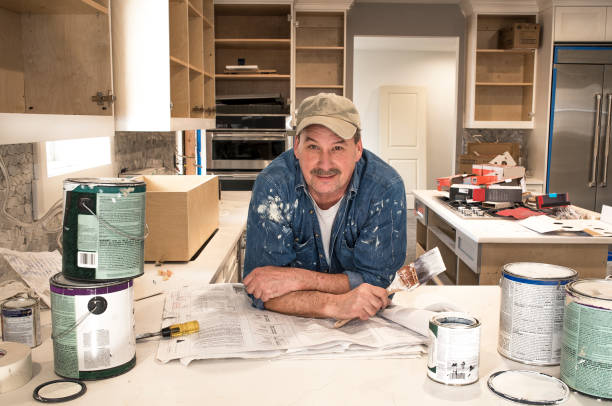How to Paint Cabinets Like a Pro: Essential Tips for a Professional-quality Result
Are you looking to give your kitchen or bathroom a much-needed facelift? Painting cabinets is an easy, affordable way to do so. With the right techniques and materials, anyone can get the professional-quality result they’re after. So if you want to learn how to paint cabinets like a pro, read on!
Preparation
The first step to painting cabinets like a pro is proper preparation. Prepping the surface of your cabinets is essential for achieving professional-quality results. This means cleaning the surfaces, removing any hardware, and making sure there are no rough patches or bumps that could show through after painting. You'll also want to make sure you use a primer before applying paint; this helps ensure an even finish and prevents fading over time.

Tools and Materials Needed
Now that you’ve done the prep work, it’s time to gather the tools and materials needed for a professional-quality result. To start, you'll need a paintbrush, sandpaper, primer, paint roller and drop cloth. These are all essential items when painting cabinets like a pro – they help ensure an even finish and prevent any messes along the way.
Before beginning your project, lay down drop cloths or newspaper on the floor around your workspace to protect against any accidental spills or splatters. Then begin by sanding your cabinet surfaces with 120-grit sandpaper in circular motions until all blemishes have been smoothed out. Once complete, wipe down the surface of each cabinet with a damp cloth to remove any dust particles left behind from sanding.
Techniques for Applying Paint
When it comes to painting techniques, brush strokes are often preferred over roller strokes for many types of cabinet surfaces; roller marks often become visible after several layers of paint are applied. When brushing, use long vertical or horizontal strokes from beginning to end – short stippling motions should be avoided if possible. Additionally, different types of paints will require varying levels of pressure during application; generally speaking, thicker paints such as acrylic latex enamels need more pressure than thinner varieties like water-based finishes.
Finally, always remember to apply two coats of high-grade primer before starting any painting project; this helps ensure that each layer of paint adheres properly and prevents inconsistencies between coats. With these essential tips in mind, you can create an even finish with minimal effort!
Finishing Touches
When it comes to creating a professional-quality finish on painted cabinets, these special touches are essential. Antique glaze should be applied in thin layers; too much product can make the result appear muddy or blotchy. When selecting cabinet hardware, consider both form and function: knobs or pulls should complement the style of the cabinetry as well as provide easy access when opening drawers or doors. And again, always remember to apply a protective topcoat sealer once all painting is complete.

Caring for Painted Cabinets
Once you’ve finished painting your cabinets, it’s time to think about long-term maintenance. Caring for painted cabinets properly will ensure they look great and last longer. With a few key steps and regular upkeep, you can keep your beautiful new paint job looking fresh and inviting for years to come.
Caring for painted cabinets is cleaning them regularly with the right products. Avoid harsh cleaners or abrasive sponges – instead, use gentle detergents like dish soap diluted in warm water and soft cloths such as microfiber towels. This will help remove dirt and grease without damaging the finish. Additionally, waxing or polishing your cabinets every six months can add protection from stains and wear while also giving them an extra shine.
Conclusion
Painting cabinets like a pro is achievable with the proper preparation and techniques. The result of professional-quality painted cabinets is worth the effort if done correctly. It's important to use quality materials, such as high-grade paint and primer, for best results. With practice, anyone can become an expert at painting their own cabinets.
The truth behind this theory can be found in the success stories of DIYers who have taken on the challenge of transforming their kitchen or bathroom cabinets into works of art. After they take time to prep properly, apply several layers of paint using the right techniques, make finishing touches, and care for their painted cabinets - all while troubleshooting any issues that arise along the way - these proud homeowners are rewarded with beautiful end results that look professionally finished yet still reflect their unique personalities and design preferences. This transformation brings them satisfaction and pride knowing that it was all achieved through hard work and dedication.
If you're looking for more ideas about this topic, feel free to check this blog post from Spray Tex Painting.

